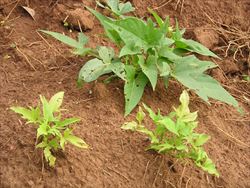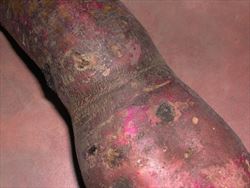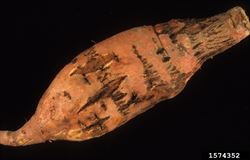- Narrow. East Africa. Major disease of sweet potato caused by two viruses interacting - Sweet potato chlorotic stunt virus (SPCSV) and Sweet potato feathery mottle virus (SPFMV). On their own, they do relatedly little harm (see Fact Sheets nos. 375, 258).
- SPCSV allows SPFMV to multiply many times more than when alone.
- Symptoms are variable: leaves with yellow blotches, mosaics, mottles, deformed; vines stunted. Yields of storage roots low, depending on time of infection and variety. Impact - farmers forced to grow low-yielding resistant varieties.
- Spread: SPCSV by whiteflies; SPFMV by aphids. Also, in cuttings for propagation. Over longer distances, storage roots sent to markets. Viruses survive between crops in vines left in fields, in storage roots used for spouts, and in wild Ipomoea (morning glory).
- Biosecurity: risk from different virus strains and unofficial introductions of vines/storage roots. Official movement of germplasm should always follow the FAO/IPBGR Technical Guidelines.
- Biocontrol: none.
- Cultural control: carefully select planting material – if unsure establish nursery from cuttings or storage roots and use the sprouts; plant new plots >15m (distance whiteflies fly) away from old crops (with barrier crops between, e.g., maize); avoid planting downwind from old plots; rogue diseased plants during first month from planting; collect vines after harvest and bury, burn or compost; avoid planting in same field as previous crop (unharvested storage roots provide source of viruses). Use local or NASPOT varieties selected or bred for tolerance.
- Chemical control: not an appropriate method.







